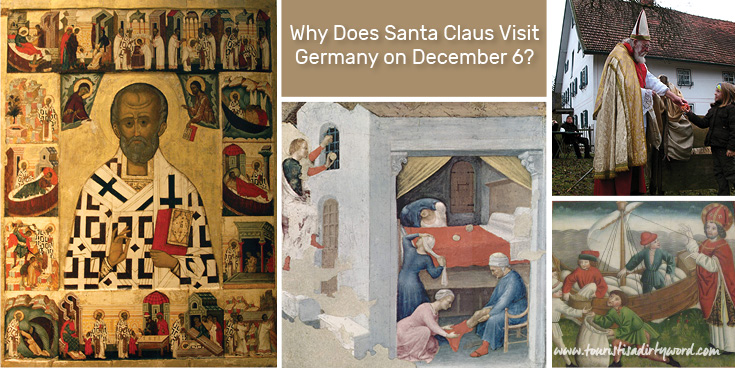December 6th is a special day for children in Germany and many other European countries. It is Nikolaus or Nikolaustag, named after Saint Nicholas. There are many miraculous stories about him, and some belong to the realm of imagination, others may have actually contributed to the yearly tradition.

Tidbits of Known history
The following is known about Saint Nicholas: The young Nicholas was born between 270 AD and 286 AD in today's Turkey to wealthy parents. When he was 19, he was ordained a priest. Soon, as Abbot, he heads the monastery of Sion near Myra, near his home town, hence his other nickname Nicholas of Myra.
After the death of his parents, Saint Nicholas inherits a large fortune, which he distributes to the poor in form of gold clumps and afterwards goes on a pilgrimage to the Holy Land, today's Israel. After his return, he was elected bishop of Myra due to his just nature.
Legends Surrounding Saint Nicholas
One legend of Saint Nicholas is the grain miracle legend. Based on the advice of Saint Nicholas, the sailors of an Alexandrian grain ship unloaded some of their cargo in a city threatened by famine. When the grain ship later arrived at its final destination, the crew discovered their supply had been replenished.
Another legend describes St. Nicholas throwing three gold balls into the house of a poor man, so that his daughters can be properly married. In many pictures, Saint Nicholas is represented in simple bishop's clothing. On later pictures, three golden balls are added, which are the ones he had thrown into the poor man's house. Sometimes three oranges or apples are used to represent the gold.
How Come We Know About Him?
The legends about Saint Nicholas’ righteousness and charity made him the patron saint of sailors, travelers, pilgrims, traders, the poor, and children. The worship of Saint Nicholas spread from the middle east across Russia to all of Europe including Germany. Even today, on Saint Nicholas’ death day, on the 6th of December, he is celebrated in many countries. That is why Nikolaus has many names: in Austria he is called Nikolo, in England and Ireland he is called Father Christmas and in the Netherlands and Flanders, he is called Sinterklaas, an abbreviation for Sint Nikolaas.
Celebration of Saint Nicholas in Germany
In many regions of Germany, it is customary to place well-dressed, empty shoes outside your door on the evening of December 5th, in the hope to find well-filled shoes the next morning, even though this custom has also changed over time. While parents used to stick apples and nuts into the shoes, today toys or candy often find their way into the shoes.
By the way, naughty children are threatened with Saint Nicholas, who will not bring them any gifts on December 6. You better be nice, and also do not forget to clean the shoes before you put them outside the door. Allegedly Saint Nicholas will not deliver if you leave mud on your boots.
Follow Along
If you enjoyed this article, or these topics sound interesting to you, you'll love our weekly newsletter. You'll receive a free Germany Packing list for signing up, and you'll receive each week's newest posts every Friday. Thank you for reading!



